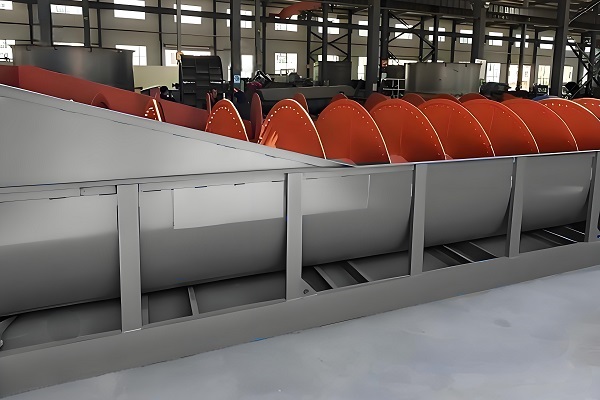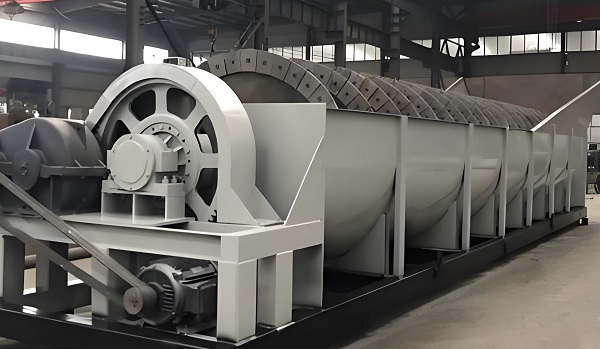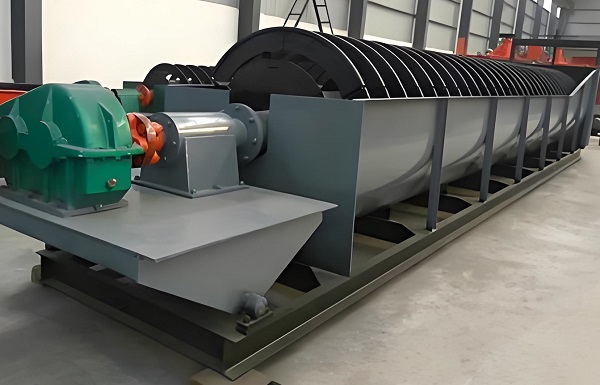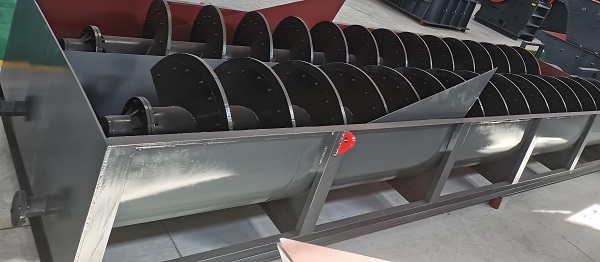Preface: In the sand and gravel processing process, the spiral sand washer is the core equipment, and its operating status is directly related to production efficiency and product quality. Scientific and reasonable maintenance and daily maintenance work can not only effectively extend the service life of the equipment, but also significantly reduce the failure rate, ensuring that production activities continue in an orderly manner.
A. Common faults and repairs of spiral sand washers

Spiral Sand Washer
1. Spiral blade failure
Wear: Wear problems are common in the process of long-term continuous contact and friction between spiral blades and sand and gravel. When the degree of wear is light, it can be repaired by surfacing process. First, it is necessary to select suitable wear-resistant welding rods and perform multiple layers of fine surfacing in the worn area to increase the thickness of the blades and restore their normal working performance. After surfacing is completed, the surface of the blades must be polished to ensure that the surface is smooth and flat to prevent the smooth transportation of sand and gravel from being hindered by uneven surface. However, if the blades are severely worn and cannot be repaired by surfacing, new spiral blades must be replaced in time. When replacing, the size and material of the new blades must be strictly controlled to ensure that they are completely consistent with the original blades, so as to ensure the stable operation of the equipment.
Deformation: If the sand washer encounters large stones or other foreign objects during operation, the spiral blades are very likely to be deformed. For slightly deformed blades, mechanical correction methods can be used for repair. With the help of professional tools such as jacks and presses, reverse force is applied to the deformed parts to gradually restore them to their original state. If the degree of deformation is serious and has affected the normal operation of the blades and the transportation of sand and gravel, new blades must be replaced. At the same time, it is also necessary to carefully check the feed port of the equipment to prevent large particles from entering again and prevent similar situations from happening again.

Spiral Sand Washer
2. Transmission system failure
Motor failure: As the power source of the spiral sand washer, common faults include motor overheating and failure to start. Motor overheating may be caused by overload operation, poor heat dissipation or internal short circuit of the motor. If it is caused by overload operation, it is necessary to check the feed volume and discharge conditions of the equipment to avoid excessive feed causing the motor to be overloaded. At the same time, clean the dust accumulated on the motor cooling fan and heat sink in time to ensure good heat dissipation. If there is a short circuit inside the motor, a professional maintenance personnel must disassemble and inspect the motor and replace key components such as damaged windings. When the motor cannot start, first check whether the power supply is normal and whether the fuse is blown. If the power supply and fuse are normal, further check the control circuit and starter of the motor to see if there is a problem of poor contact or component damage, and repair or replace the faulty parts in time.
Reducer failure: Common faults of reducers include oil leakage, gear wear, abnormal noise, etc. Oil leakage is usually caused by aging or damage of the seal. At this time, the seal needs to be replaced in time and the oil on the surface of the reducer needs to be thoroughly cleaned. Gear wear may be caused by long-term use, insufficient lubrication or excessive load. When the gear wear is light, the meshing clearance of the gear can be adjusted and the appropriate lubricant can be added. If the wear is severe, a new gear needs to be replaced. Abnormal noise may be caused by poor gear meshing, bearing damage or foreign matter inside the reducer. At this time, the reducer should be fully inspected to accurately find the source of noise and carry out targeted treatment.
3. Washing tank failure
Water leakage: After a long period of use, the washing tank may leak. The main reason is cracking of the washing tank weld or corrosion of the tank body. For cracked welds, welding can be used for repair. First, drain the water in the washing tank, carefully clean the impurities and rust around the weld, and then select suitable welding materials for repair welding. After the repair welding is completed, a water leakage test is required to ensure that the repair effect meets the standard. If the washing tank leaks due to corrosion, different treatment measures need to be taken according to the degree of corrosion. When the corrosion is light, the corroded parts can be polished and rust-removed, and then anti-corrosion paint is applied. If the corrosion is severe, part or the entire washing tank needs to be replaced.
Tank deformation: The washing tank may be deformed when it is subjected to a large external force impact or long-term uneven force. For a slightly deformed washing tank, it can be corrected by adding a support structure to the outside of the tank body, such as using channel steel, angle steel and other materials to make a support frame, fixed to the outside of the washing tank, and effectively supporting the deformed parts. If the deformation is serious and has affected the cleaning and transportation of sand and gravel, the washing tank must be repaired or replaced.
B. Daily maintenance of spiral sand washer

Spiral Sand Washer
1. Equipment cleaning
The spiral sand washer should be cleaned regularly to thoroughly remove impurities such as dust, sand and oil attached to the surface of the equipment. In particular, key components such as motors, reducers, spiral blades, etc. must be kept clean to prevent impurities from entering the equipment and affecting the normal operation of the equipment. When cleaning, you can use tools such as compressed air and brushes; for oil stains that are difficult to remove, you can use special detergents for cleaning.
3. Lubrication and maintenance
Regularly check the lubrication points: The transmission system, spiral shaft and other parts of the spiral sand washer are equipped with lubrication points, and the lubrication status of these lubrication points needs to be checked regularly. Strictly follow the requirements of the equipment manual, select appropriate lubricating oil or grease, and add or replace it according to the specified time and dosage. Generally speaking, after a new equipment has been running for a period of time, the lubrication points need to be checked and lubricated for the first time, and then a comprehensive inspection and lubrication maintenance should be carried out at regular intervals.
Ensure lubrication effect: When adding lubricating oil or grease, it is necessary to ensure sufficient lubrication. For parts such as the spiral shaft, the lubricating oil can be evenly distributed between the shaft and the bearing by rotating the shaft. At the same time, pay close attention to whether there is oil leakage in the lubrication parts. If oil leakage is found, find the cause and deal with it in time to ensure the normal operation of the lubrication system.
4. Component inspection
Bolt tightening inspection: Regularly check the connecting bolts between the various parts of the equipment to ensure that the bolts are tightened. During the operation of the equipment, the bolts may become loose due to factors such as vibration. Loose bolts will cause unstable connections between components, which will not only affect the normal operation of the equipment, but may even cause safety accidents. Therefore, it is necessary to use tools such as wrenches to tighten the bolts one by one, especially the connecting bolts between the spiral blades and the spiral shaft, the connecting bolts between the washing tank and the bracket, and other key parts.
Wearing parts inspection: For the wearing parts of the spiral sand washer, such as spiral blades, seals, transmission belts, etc., their wear degree should be checked regularly. Replace them in time according to the service life and actual wear of the wearing parts. When replacing wearing parts, choose reliable products to ensure that their performance and size are consistent with the original parts, so as to ensure the normal operation of the equipment and the sand washing effect.

Spiral Sand Washer
5. Electrical system maintenance
Check the electrical circuit: Check the electrical circuit regularly for damage, aging, short circuit and other problems. If the circuit is found to be damaged, it needs to be bandaged or replaced in time. For aging circuits, new wires should be replaced according to the electrical specifications of the equipment. At the same time, check whether the joints of the electrical circuits are firm, loose, oxidized, etc., to ensure reliable electrical connection.
Clean electrical components: Regularly clean the dust and debris on electrical components such as motors and control cabinets to prevent poor heat dissipation or short circuit of electrical components due to dust accumulation. You can use dry compressed air or brushes and other tools to carefully remove dust from the surface of electrical components. At the same time, check the working status of electrical components, such as whether the contacts of contactors, relays, etc. are normal, and repair or replace them in time if problems are found.
PS: The repair and daily maintenance of spiral sand washers involve all aspects of the equipment. By timely and effective handling of common faults, and solid daily cleaning, lubrication, component inspection and electrical system maintenance, the operating stability and reliability of the equipment can be effectively improved, the service life of the equipment can be extended, and a solid guarantee can be provided for the efficient production of related industries such as sand and gravel production. In actual operation, operators and maintenance personnel must strictly perform maintenance and repair work in accordance with the equipment's instruction manual and relevant operating procedures to ensure the safe operation of the equipment and maintain good performance.
Save Time! Get A Detailed Quotation Quickly.
